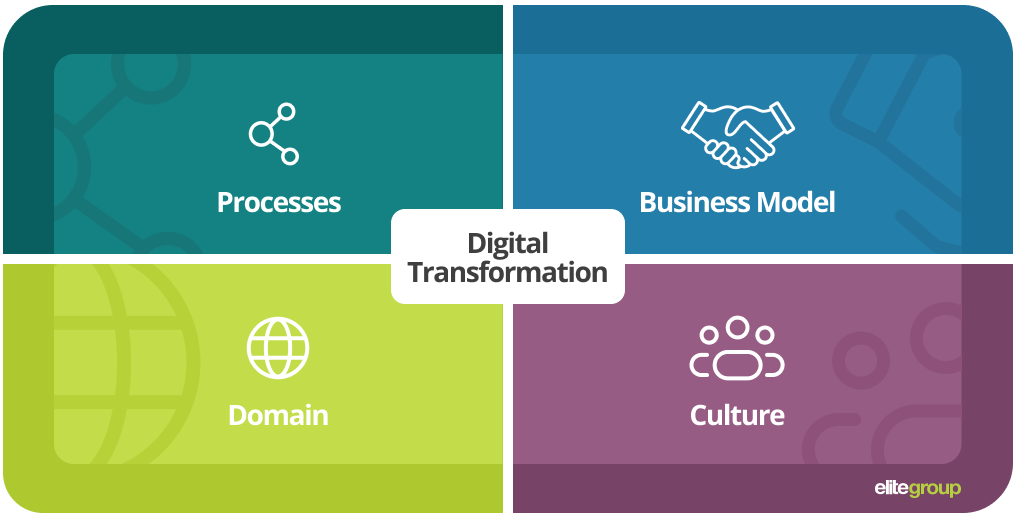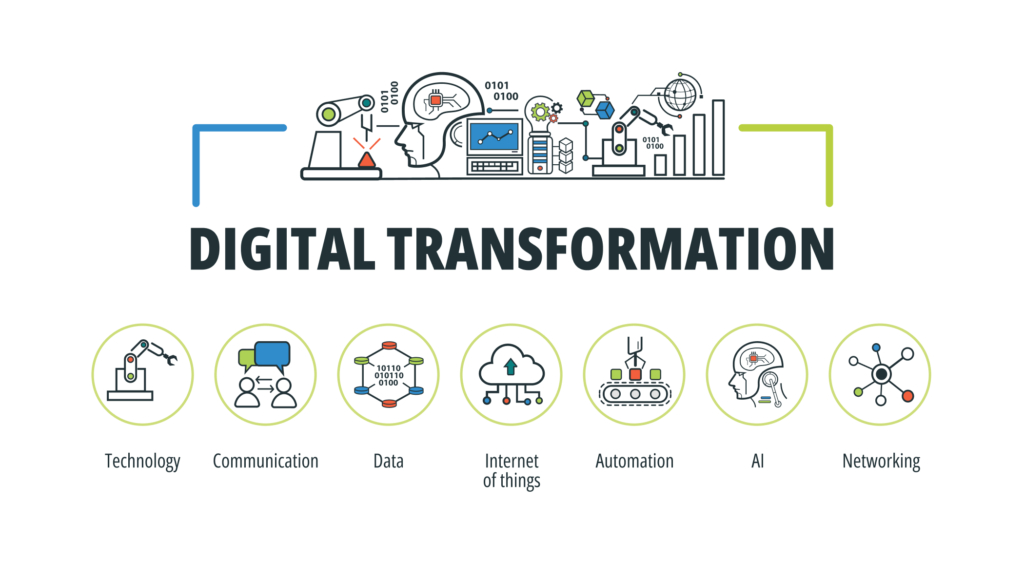Navigating Travel Industry Risks with Intelligent Communications
We’re going to explore some real-life unforeseen circumstances that the travel industry has had to navigate and how intelligent communications solut...
Digital transformation is much more than looking for the latest technology to bring into your company.
It’s a business-wide transformation that touches everything from process to culture, to the customer experience and how you use data for better decision-making.
While going through a ‘digital transformation’ is no easy thing (70% of digital transformations fail) it can have a hugely beneficial impact on your business.
And although digital transformation can impact every area of a company, it tends to fit into four key business areas.
That’s what we take about in this blog.
At Elite Group we’ve taken hundreds of companies through successful digital transformations, whether it’s transitioning away from fixed phone lines to cloud based phone systems.
Or deploying full unified communications as a service and contact centre as a service platform into their company.
Here are our key takeaways that can help you get through the process and improve your business.
Let’s start by defining what a digital transformation is.
At its basic level digital transformation uses new technology, processes and business change to achieve an outcome, whether that’s:
As we’ve said, while digital transformation has far-reaching benefits across any business, it tends to focus on four key business areas.

Digital transformation impacts every business area from HR and accounting, to marketing, sales and the customer experience.
Within each of these departments, there will be processes that can be greatly improved.
These processes tend to be highly manual and repetitive.
They’re important, but they’re monotonous and don’t require a lot of thought (which is why they’re usually a drain on morale)
For example in the customer experience arena, the manual process of routing callers to the right department is highly repetitive and also doesn’t give the customer the best experience.
Digital transformation through intelligent call routing – for example – can not only automatically transfer callers to the right person based on their enquiry, but it can also prioritise which callers are dealt with first based on their previous call records.
This not only achieves removing a repetitive task from an employee so they can focus on other tasks, but it also improves the experience the customer has too.
Digitally transforming a business process doesn’t have to be difficult, but you should follow a framework in order to give you the best chance of success.

Goal setting is an essential first step of any digital transformation, and not going through this process is one of the big reasons most projects fail.
You should look at processes in your businesses that aren’t working as well as they could, and set goals for how you can improve them.
For example:
“We want to use automatic ticketing to improve the speed with which customer enquiries are dealt with.”
Once you know the goal you want to hit, you need to take a baseline reading of how the process is performing now.
This is critical as it’s the only way to judge any improvements later on.
For example, your current time to enquiry resolution could be 52 hours – and you want to bring it down to 48.
Not getting employee and stakeholder buy-in to your digital transformation project is a sure way for it to fail.
Without proper buy-in from senior stakeholders, you likely won’t get the backing or finances to implement a proper transformation.
Without employee buy-in you’ll never get the technology rolled out as effectively as you could.
For any process or workflow you should have an idea of what the ideal process should look like.
For example a customer enquiry begins at A, if the enquiry can’t be dealt with it moves to B, with C being the point of escalation etc
And this process should be written down from start to finish.
This will help you focus on the design of your digital transformation to ensure you increase your chances of getting the desired result.
Once the project has gone live, you should focus on the immediate improvements/ or failings as well as the initial employee reaction to the new processes.
These immediate insights give an early indicator as to the hurdles that need to be overcome quickly before confidence in the process is lost.
However, these initial results shouldn’t be used to make decisions on longer time horizons.
Once the project has launched you should continually monitor whether it’s producing the results you wanted.
If it’s not (and even if it is) you should use your data to understand where the pros and cons of the new workflow are, and use these insights to improve your processes further.
If you’re wondering how digital transformation can change entire business models, just look back over the last few years.
At the end of 2019, and beginning of 2020, who could have imagined the way we’d be working today?
Remote work had been around before 2020, but never to the same level.
Within the space of a few years, businesses that had been entirely office based (with every intention to stay that way) had gone fully remote and used technology to completely change their business models.
You can also see across multiple industries how tech (or tech businesses) have transformed business models.
Look at how Apple disrupted the music business and then how streaming services took it a step further.
Look at how Netflix changed the video and film distribution business (and how many other businesses have now followed suit with their own streaming services).
Or how Amazon changed shopping into a complete online (and far more convenient) experience.
One thing that’s often overlooked in the digital transformation space, is the potential it creates for new products and services.
If you’re looking out for it, going through a digital transformation allows your business to move into new industries and have success with other products or services.
A prime example of this is Amazon and it’s move to Amazon Web Service.
The initial move happened because Amazon was using a lot of cloud computing to manage its own infrastructure as the shopping giant grew.
Now AWS is one of the leading cloud computing providers in that space – all because of a digital transformation.
It can’t be stressed enough how important company culture is in the space of digital transformation.
You can identify and bring in the best new technology, but unless you have a culture that adopts change and new ways of working, you’re never going to get the best out of the technology.
And according to research published by PwC, there is a huge disconnect between executives and employees when it comes to new tech.
While 90% of execs say their company pays attention to people’s needs when introducing new technology, only 53% of employees agree.
Failing to build culture into your digital transformation can have far-reaching, and long-lasting implications for your digital transformation project, including:
There are lots of reasons employees resist new technology.
Some will be suspicious about whether the new tech is being brought in to help them or eventually replace them.
Others believe it’s just another new system they’ll have to learn before it’s replaced in another 12 months (a side effect of no long-term strategy for your digital transformation).
On the other hand, building a culture around digital means employees are much more likely to embrace change and allow for more experimentation with new technology in their role.
Part of creating a culture around digital transformation means embracing a few key beliefs:
Although a digital transformation undoubtedly carries many benefits that can not only improve your business in the short-term but protect it from unknown threats in the future, you will likely have a few challenges to overcome to ensure your project is a success.
This is especially true if the technology is something you’ve never had in the business before.
Below are some of the key digital transformation challenges we see time and again with clients:

Another bottleneck towards a successful digital transformation project is not having an ‘owner’ of the project.
Without proper leadership, these projects tend to move off point and lose the backing of senior stakeholders when they don’t see progress.
Creating a steering group for your digital transformation creates responsibility for the project and also establishes accountability for getting the project done.
In terms of who should be involved in the digital transformation, there’s no definitive list but it could include:
A digital transformation can either take your business to a new level, or it can cause more disruption than it solves if you don’t manage the process.
Working with Elite Group you’ll have a team of digital transformation experts behind you all the way.
We’ve worked with hundreds of clients already to help them map out, execute and optimise a digital transformation project to improve their business.
You can see examples of our digital transformation projects in our case studies to see how we work with clients.
Or if you’re ready to get more information about how a digital transformation can change your business for the better, get in touch